Houston Inspira
5 Selected Complete Communities
Dear Houstonians,
I am optimistic and excited about the Houston Inspira initiative aimed at impacting five of the Complete Communities: Acres Homes, Alief / Westwood, Kashmere Gardens, Near Northside, and Second Ward. These communities have been overlooked and under-resourced, all while experiencing inequity on many fronts for decades. The existence of concrete batch plants and the chemicals emitted into these neighborhoods, schools, and parks where our children learn and play, have heightened health risks and disrupt their quality of life.
I am thankful for the Environmental Protection Agency (EPA), under Administrator Michael S. Regan, for their close lens on equity. It is encouraging to have the Administration share our concerns and know the names and faces of those residents who are significantly impacted by this public health crisis and environmental injustice.
I look forward to the collaboration between the environmental organizations and Complete Communities as well as the creative elements by local artists and storytellers to help amplify our stories, while bridging the gap between equity and opportunity for all residents to succeed and build resilience. Together, there is nothing our city cannot achieve.
Sylvester Turner
Mayor
As part of Mayor Turner’s signature initiative, Complete Communities focuses on bridging the gap between equity and opportunity for disadvantaged communities. The five selected communities have been economically disadvantaged for decades, and to make matters worse, these same neighborhoods have been disproportionately impacted by several health risks that are exacerbated by COVID-19. The community maps outline concrete batch plants, health risks from Benzene and PM2.5 exposure, TCEQ Benzene and PM2.5 air quality monitors, COVID-19 positivity rate as of 1/27/22.
Acres Home • Alief / Westwood • Kashmere Gardens • Near Northside • Second Ward
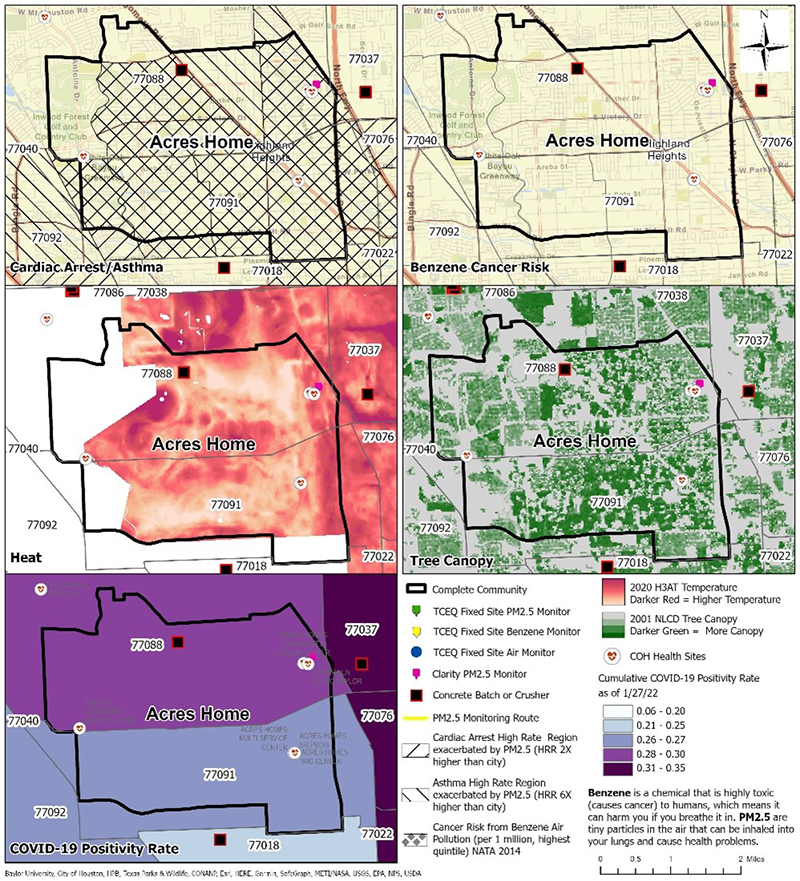
Acres Home residents are 60% non-Hispanic Black, 31% Hispanic, and 9% non-Hispanic White and other races. Of the three health effects being tracked as posing an increased risk due to exposure to pollution (i.e., cardiac arrest, asthma attacks, and cancer), analysis of the city’s EMS ambulance data indicates increased risk for cardiac arrest and asthma attacks in Acres Home compared to the rest of the city. The data shows a 33% increase in cases of cardiac arrest, a 165% increase in cases of adult asthma attacks, and a 184% increase in cases of childhood asthma attacks. Additionally, the EPA indicates a risk of 2.6 additional cancer cases in 1 million people from exposure to benzene in Acres Homes.
Back up to 5 Selected Complete Communities
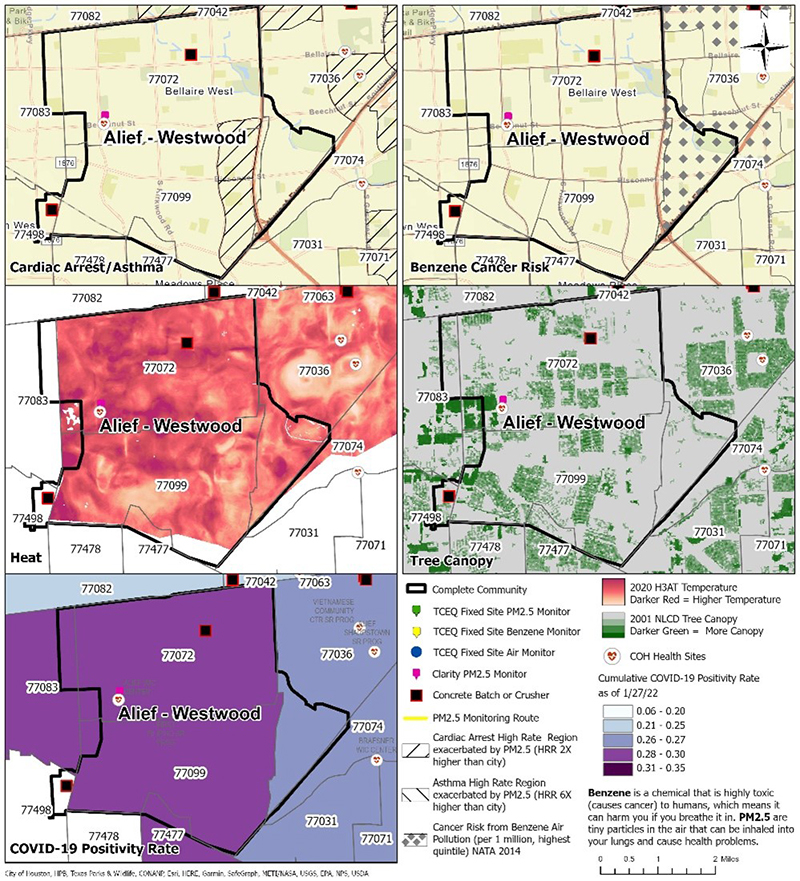
Alief residents are 51% Hispanic, 23% non-Hispanic Black, 19% non-Hispanic Asian, and 7% non-Hispanic White and other races. Of the three health effects being tracked as posing an increased risk due to exposure to pollution (i.e., cardiac arrest, asthma attacks, and cancer), analysis of the city’s EMS ambulance data indicates increased risk for adult asthma attacks in Alief compared to the rest of the city. The data shows a 15% increase in cases of adult asthma attacks. In addition, the EPA indicates a risk of 2.5 additional cancer cases in 1 million people from exposure to benzene in Alief.
Back up to 5 Selected Complete Communities
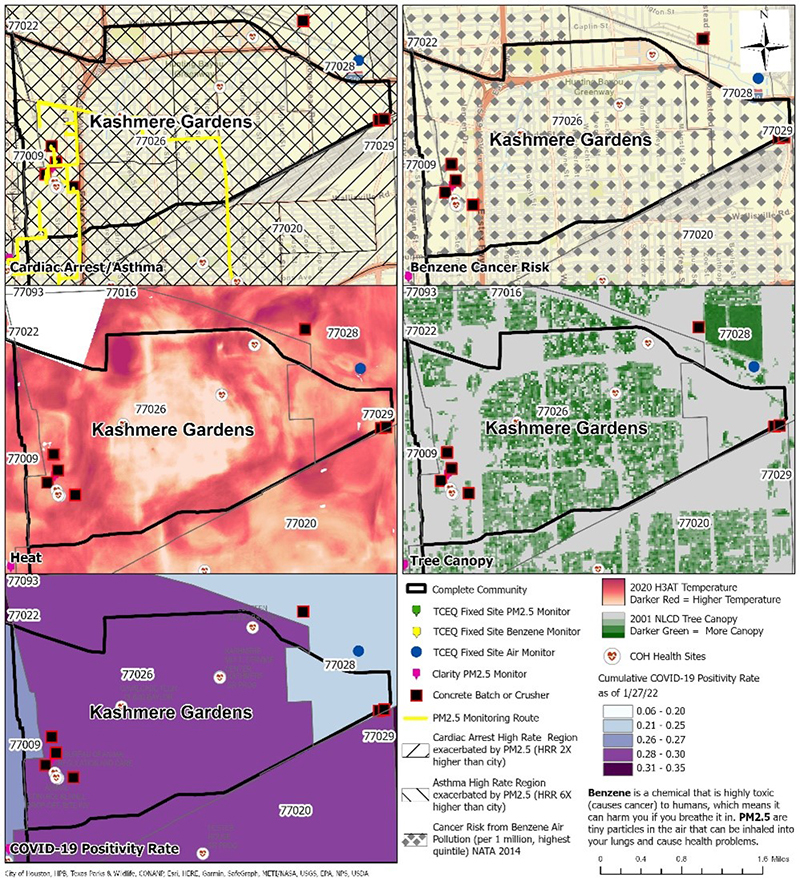
Kashmere Gardens residents are 59% non-Hispanic Black, 36% Hispanic, and 5% non-Hispanic White and other races. Of the three health effects being tracked as posing an increased risk due to exposure to pollution (i.e., cardiac arrest, asthma attacks, and cancer), analysis of the city’s EMS ambulance data indicates increased risk for cardiac arrest and asthma attacks in Kashmere Gardens, compared to the rest of the city. The data shows a 56% increase in cases of cardiac arrest, a 330% increase in cases of adult asthma attacks, and a 156% increase in cases of childhood asthma attacks. Additionally, the EPA indicates a risk of 3.0 additional cancer cases in 1 million people from exposure to benzene in Kashmere Gardens.
Back up to 5 Selected Complete Communities
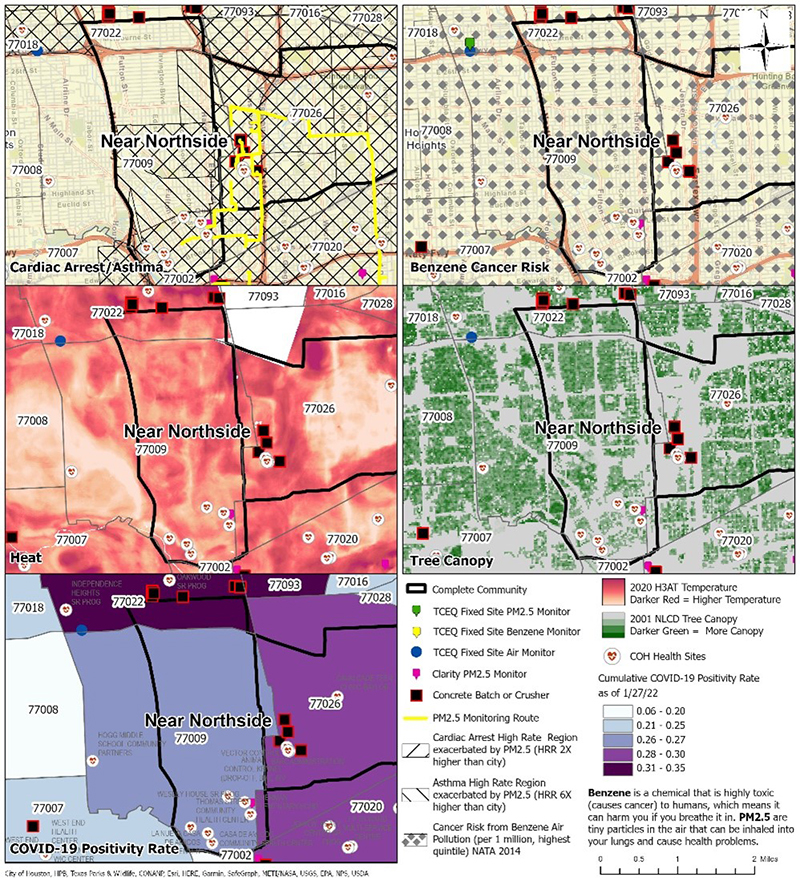
Near Northside residents are 82% Hispanic, 9% non-Hispanic White, and 9% non-Hispanic Black and other races. Of the three health effects being tracked as posing an increased risk due to exposure to pollution (i.e., cardiac arrest, asthma attacks, and cancer), analysis of the city’s EMS ambulance data indicates increased risk for cardiac arrest and asthma attacks in Near Northside, compared to the rest of the city. The data shows a 27% increase in cases of cardiac arrest, a 135% increase in cases of adult asthma attacks, and a 21% increase in cases of childhood asthma attacks. Additionally, the EPA indicates a risk of 3.1 additional cancer cases in 1 million people from exposure to benzene in Near Northside.
Back up to 5 Selected Complete Communities
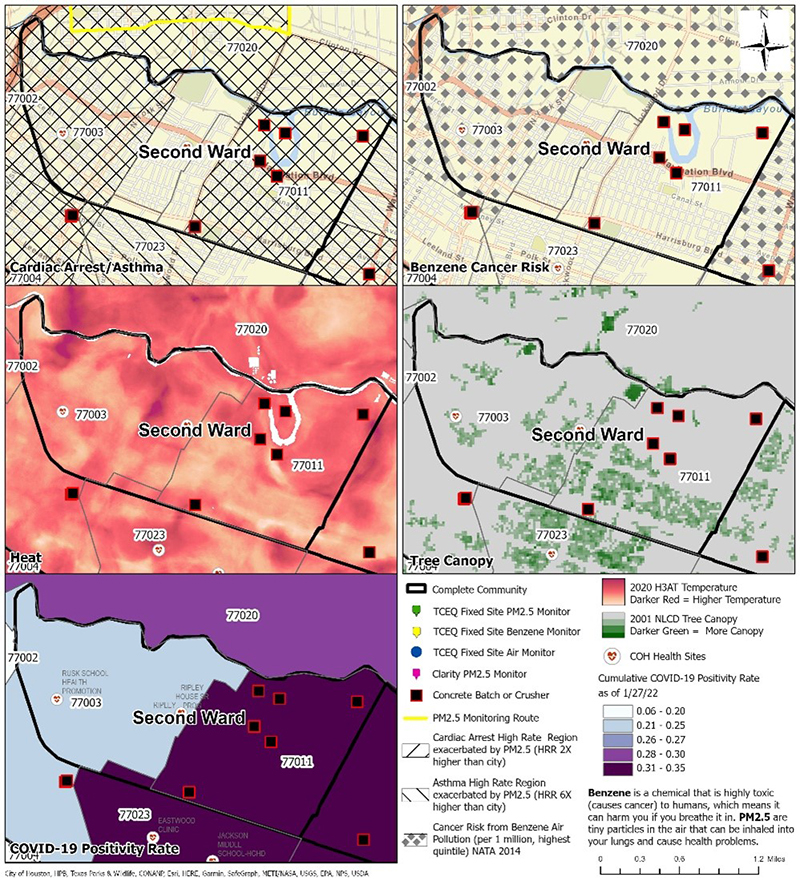
Second Ward residents are 73% Hispanic, 15% non-Hispanic Black, 9% non-Hispanic White, and 3% non-Hispanic Asian and other races. Of the three health effects being tracked as posing an increased risk due to exposure to pollution (i.e., cardiac arrest, asthma attacks, and cancer), analysis of the city’s EMS ambulance data indicates increased risk for cardiac arrest and asthma attacks in Second Ward, compared to the rest of the city. The data shows a 23% increase in cases of cardiac arrest, a 48% increase in cases of adult asthma attacks, and a 71% increase in cases of childhood asthma attacks. Additionally, the EPA indicates a risk of 2.9 additional cancer cases in 1 million people from exposure to benzene in Second Ward.
Back up to 5 Selected Complete Communities
About Houston Inspira Public Health Storytelling Campaign
The City of Houston was awarded a $200,000 grant by the U.S. Environmental Protection Agency (EPA) in October 2021 to create and launch a public health campaign, “Houston Inspires/Houston Inspira”. The Mayor’s Offices of Cultural Affairs and Government Relations are leading this work with the Office of Complete Communities, Resilience and Sustainability and the Houston Health Department. Additionally, city departments will engage environmental organizations, artists, and storytellers to inspire awareness and action to improve health and safety outcomes. The 5 Complete Communities selected have the highest amount of concrete batch plants. As a result, these neighborhoods have been adopted by local environmental partners to increase capacity building, engage in public forums, storytelling, and other innovative programs that raise awareness of health concerns around COVID-19 and air pollutants, particularly PM2.5 and benzene.
- This effort aligns with Resilient Houston Goal 5. We will invest in arts and culture to strengthen community resilience. Through this project, Houston will promote local artists to engage Houstonians and create awareness on the environmental justice challenges and health risks that our most vulnerable populations face.
